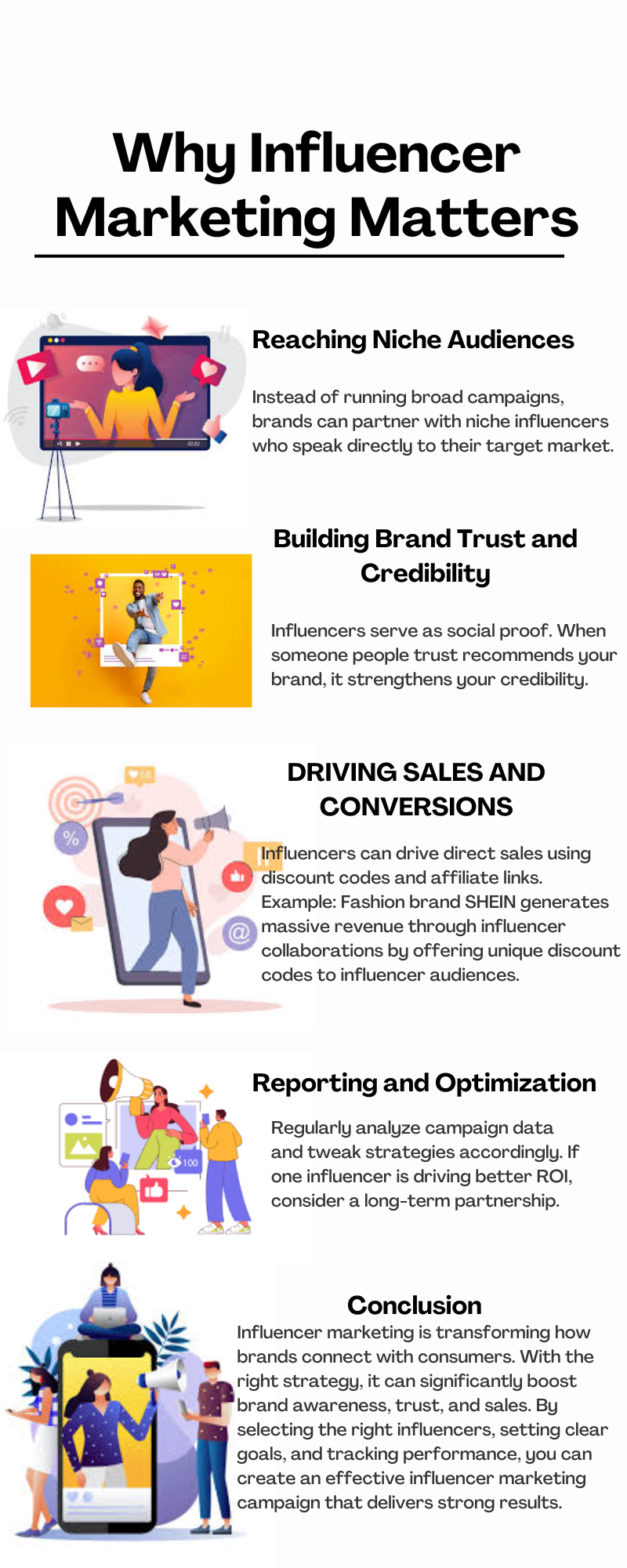
Did you know that 49% of consumers trust recommendations from influencers more than traditional advertisements? The world of marketing is shifting, and influencer marketing is at the forefront of this transformation. This guide will help you understand what influencer marketing is, why it matters, and how to implement it effectively.
What is Influencer Marketing?
Influencer marketing is a strategy where brands collaborate with individuals who have a strong online presence and influence over their audience. These influencers create content that showcases your product or service, making it feel more organic compared to traditional ads.
Why is it Effective?
- Higher Engagement: Influencer posts often receive 5x more engagement than branded content.
- Trust & Authenticity: Around 92% of consumers trust influencer recommendations over direct brand advertisements.
- Better ROI: Businesses earn an average of $5.78 for every $1 spent on influencer marketing.
Defining Influence
Not everyone with a large following is an influencer. True influence is based on three key factors:
- Reach: The number of people they can potentially engage.
- Relevance: How well their content aligns with your brand.
- Resonance: The level of engagement and connection they have with their audience.
A perfect influencer has all three qualities, ensuring that their recommendations drive real results.

Types of Influencers
Influencers are categorized based on their follower count:
- Nano-Influencers (1K-10K followers): Small but highly engaged communities.
- Micro-Influencers (10K-100K followers): High engagement and cost-effective.
- Macro-Influencers (100K-1M followers): Wider reach with decent engagement.
- Mega-Influencers (1M+ followers): Celebrity-level exposure but expensive.
- Virtual Influencers: Virtual influencers are AI-powered personas that appear on social media platforms and engage audiences just like real human influencers. They’re designed to look and act like people—often with hyper-realistic visuals, curated personalities, and even fictional backstories.
Real-World Data:
- Micro-influencers have 60% higher engagement rates than macro-influencers.
- 82% of consumers are likely to buy based on a micro-influencer's recommendation.
The Role of Authenticity
Authenticity is the backbone of influencer marketing. Audiences can detect inauthentic endorsements, and brands that fail to partner with genuine influencers risk losing credibility.
Key Takeaways:
- Avoid influencers who purchase fake followers.
- Partner with influencers who genuinely love your product.
- Transparency is crucial: always disclose paid partnerships using #ad or #sponsored to comply with FTC regulations.
Why Influencer Marketing Matters
Influencer marketing is an essential tool for brands looking to grow their reach and sales.
Reaching Niche Audiences
Instead of running broad campaigns, brands can partner with niche influencers who speak directly to their target market.
Example: A brand selling eco-friendly skincare products collaborates with a sustainability influencer. Their audience is already interested in green beauty, making conversions easier.
Building Brand Trust and Credibility
Influencers serve as social proof. When someone people trust recommends your brand, it strengthens your credibility.
- 70% of teens trust influencers more than traditional celebrities.
- 89% of marketers say ROI from influencer marketing is comparable to or better than other channels.
Driving Sales and Conversions
Influencers can drive direct sales using discount codes and affiliate links.
Example: Fashion brand SHEIN generates massive revenue through influencer collaborations by offering unique discount codes to influencer audiences.

Developing Your Influencer Marketing Strategy
Define Your Goals and Target Audience
- What do you want to achieve?
- Brand Awareness
- Website Traffic
- Increased Sales
Understanding your audience helps in selecting the right influencers.
Finding the Right Influencers
Use tools like Upfluence, HypeAuditor, and AspireIQ to find influencers who align with your brand values.
Setting a Budget
- Nano-influencers: $10 - $100 per post
- Micro-influencers: $100 - $500 per post
- Macro-influencers: $5,000 - $10,000 per post
- Mega-influencers: $50,000+ per post
Measuring the Success of Your Influencer Marketing Campaigns
Key Performance Indicators (KPIs)
- Reach: Number of people exposed to the content.
- Engagement: Likes, comments, shares, and saves.
- Website Traffic: Click-through rate from influencer posts.
- Conversions: Purchases made via influencer links/codes.
Tools for Tracking and Analysis
- Google Analytics: Monitors traffic from influencer campaigns.
- Instagram & TikTok Insights: Tracks engagement metrics.
- Affiliate Platforms (Refersion, Rakuten): Measures sales from influencer links.
Reporting and Optimization
Regularly analyze campaign data and tweak strategies accordingly. If one influencer is driving better ROI, consider a long-term partnership.
Common Mistakes to Avoid
- Not Doing Your Research: Partnering with influencers whose audience doesn't align with your brand.
- Lack of Transparency: Failing to disclose sponsored content can result in legal issues.
- Failing to Track Results: Without tracking, you won’t know if your campaign is successful.
The Future of Influencer Marketing
The Rise of Micro-Influencers
Brands are shifting towards micro-influencers because they offer better engagement and authenticity at a lower cost.
The Growing Importance of Video Content
With TikTok, Instagram Reels, and YouTube Shorts dominating social media, video content will continue to be a priority.
Stats:
- 86% of businesses use video marketing.
- 80% of people recall a video ad they watched in the past month.

Conclusion
Influencer marketing is transforming how brands connect with consumers. With the right strategy, it can significantly boost brand awareness, trust, and sales. By selecting the right influencers, setting clear goals, and tracking performance, you can create an effective influencer marketing campaign that delivers strong results.
So, are you ready to dive into influencer marketing? Start building your strategy today!
Images by Freepik.
Share this post
Leave a comment
All comments are moderated. Spammy and bot submitted comments are deleted. Please submit the comments that are helpful to others, and we'll approve your comments. A comment that includes outbound link will only be approved if the content is relevant to the topic, and has some value to our readers.

Comments (0)
No comment